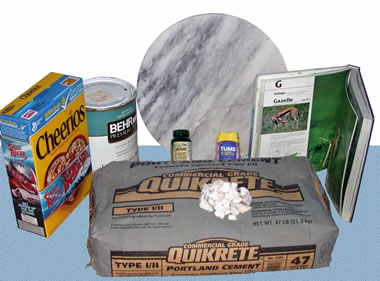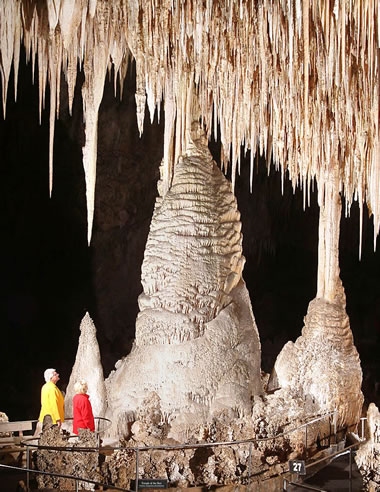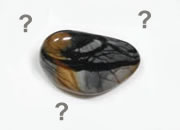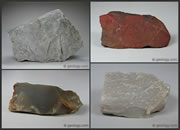Limestone: A Crucial and Versatile Industrial Mineral Commodity
By James D. Bliss, Timothy S. Hayes, and Greta J. Orris, USGS -- Republished from USGS fact sheet 2008-3089.

Products made with limestone: Limestone is an essential mineral commodity of national importance. Some of the many products made using limestone are shown in this photograph: breakfast cereal, paint, calcium supplement pills, a marble tabletop, antacid tablets, high-quality paper, white roofing granules, and portland cement. (USGS photograph; use of trade, firm, or product names is for descriptive purposes only and does not imply endorsement by the U.S. Government.)
| Limestone, as used by the minerals industry, is any rock composed mostly of calcium carbonate (CaCO3). Although limestone is common in many parts of the United States, it is critically absent from some. Limestone is used to produce Portland cement, as aggregate in concrete and asphalt, and in an enormous array of other products, making it a truly versatile commodity. Portland cement is essential to the building industry, but despite our Nation's abundance of limestone, there have been cement shortages in recent years. These have been caused in part by a need to find new areas suitable for quarrying operations. To help manage our Nation's resources of such essential mineral commodities, the U.S. Geological Survey (USGS) provides crucial data and scientific information to industry, policymakers, and the public. |

Indiana limestone in the Apex Building: Many buildings in the Nation's capital are covered with limestone. The Apex Building/Federal Trade Commission has an upper exterior of Indiana limestone. (USGS photograph.)
What is Limestone?
"Limestone" means any rock formed mostly of calcium carbonate (CaCO3), but to geologists, limestone is only one of several types of "carbonate rocks." These rocks are composed of more than 50% carbonate minerals, generally the minerals calcite (pure CaCO3) or dolomite (calcium-magnesium carbonate, CaMg[CO3]2) or both.
How Does Limestone Form?
Most carbonate rocks were deposited from seawater. These sedimentary carbonate rocks are common on every continent and have formed through most of geologic history; they are still forming today in the tropics as coral reefs and at the bottoms of shallow seas.
Marine limestone forms because seawater has high concentrations of two key dissolved chemicals-calcium (Ca++) and bicarbonate (HCO3-) ions. In the near-surface layer of most oceans, corals, clams, and other sea-dwelling creatures use these two chemicals to make protective shells by combining them to form calcite or "aragonite," which is the same chemical composition as calcite but has a different crystal form.

Sinkhole in Winter Park, Florida: Great volumes of limestone can be dissolved and carried away by surface water and groundwater. This creates caves, such as Carlsbad Caverns in New Mexico (photo below). In humid climates, cave formation is especially common, and sinkholes may develop where cave ceilings collapse. A sinkhole about 240 feet across at ground level opened in 1981 in Winter Park, Florida, when the ceiling of an underlying limestone cave collapsed. The cave and sinkhole are in the Cypresshead Formation, which is an important aquifer in central Florida. In cavernous limestone aquifers, contaminants in groundwater move much faster than in other types of rocks, so quarries in such areas are special concerns. (USGS photograph.)
Formation of Dolomite from Limestone
Some limestones have been changed by the introduction of magnesium in groundwater. Magnesium in groundwater may convert some or all of the calcite in the limestone to dolomite. Also, some rocks formed near the shores of ancient seas in arid climates were mostly dolomite at the time they were deposited.

Limestone cave: Stalactites hang from the ceiling, and stalagmites rise from the floor of Carlsbad Caverns, New Mexico, within 260-million-year-old limestone. (National Park Service photograph.)
Other Types of Carbonate Rock
Limestone comes in many different varieties. Chalk is a very fine-grained, porous marine limestone composed almost entirely of microscopic fossils. Travertine is a freshwater sedimentary limestone that has very thin, crenulated layers and is commonly formed at springs. Marble is a carbonate rock, usually a marine limestone, that has been squeezed and deformed like plastic by great heat and pressure deep beneath the Earth's surface. This process is called "metamorphism." There are also rare "igneous" carbonate rocks that have crystallized from molten magma in the same way that lavas or granites have. These are called "carbonatites," and this rock type is mined at a few places in the world as industrial limestone.
Mining Carbonate Rocks
Sedimentary limestone deposits can be extensive, covering hundreds of square miles, and can be relatively uniform in thickness and quality. Therefore, limestone quarries can be large and long lived, mining limestone layers that can be hundreds of feet thick over areas of several square miles. Many quarries produce multiple products, and crushed rocks that are not pure enough for certain uses may still be suitable as road aggregate. Marble quarries can also be very large. However, these rocks that were once regularly bedded have been metamorphosed into irregularly shaped bodies that are more difficult and costly to mine.
In large parts of the United States there are extensive deposits of marine limestone of various ages from a few thousand to more than 350 million years old. Some deposits have chemical grades as high as 95% CaCO3. However, some areas are completely without any suitable limestone deposits. Most of the cost of limestone to the customer is determined by how far away it comes from and how it is shipped. Shipping by barge on water is cheaper than by train which, in turn, is cheaper than shipping by truck.
Uses of Limestone
Limestone has many industrial uses and can be used as mined or processed into a wide variety of products. It is the raw material for a large variety of construction, agricultural, environmental, and industrial materials.
Limestone is used in construction almost everywhere. In 2007, crushed limestone was 68% of all crushed rock produced in the United States. Also, limestone is the key ingredient in making Portland cement. Despite our Nation's abundance of limestone, there have been cement shortages in recent years.
Some of the purest of natural limestones are marbles. For centuries, marble has been the decorative stone of choice in government buildings and public statues. Travertine is also used as a dimension stone in tiles and tabletops. Some white limestone is simply crushed and sieved for use in landscaping and roofing.
Powdered limestone is used to remove impurities from molten metals like steel. It can also remove toxic compounds from the exhaust of coal-burning power plants. Limestone is used as a filler in a variety of products, including paper, plastic, and paint. The purest limestone is even used in foods and medicines such as breakfast cereals and calcium pills.
Limestone is also the raw material for making lime (CaO) that is used to treat soils, purify water, and smelt copper. Lime has many additional uses in the chemical industries.
Dolomites are commonly less suitable than other industrial limestones for most applications. Most dolomite that is mined is simply crushed and sieved for use as aggregate in concrete or asphalt.
The Portland Cement Shortage
Portland cement is one of the most important products made from limestone. It is essential in many construction applications. The United States is not self-sufficient in cement and must import it from other countries to make up for shortfalls. Imports of clinker (the product from the first step in making cement) and finished cement accounted for about 23% of total U.S. cement sales in 2006. In the years just prior to 2007, Portland cement was in seriously short supply in the Nation. Competition from other countries, an inadequate ocean transport system, and underestimated cargo space requirements were among the causes.
When Portland cement was in very short supply, its price increased significantly. Consumers sought substitutes. They used pressure-treated wood, insulated steel, and polystyrene in panels, and even redesigned building footers to reduce the amount of cement needed. Cement shortages also caused construction delays that resulted in increased costs for roads, bridges, and buildings.
Sources of Limestone in the Future
Establishing new limestone quarries and cement plants in the United States is a slow process, and supply shortfalls require time to correct. It takes about 2 years to build a new cement plant, and the permitting process can take much longer - 8 to 10 years. Perhaps an even more challenging problem is that people may not welcome new quarries and plants to their area. In spite of these obstacles, many U.S. cement companies are in the process of expanding and modernizing their operations.
When an area of suitable and mineable rock is swallowed up by urban growth or when mining becomes prohibited by legislation or zoning, the result is called "resource sterilization." Limestone is a material of national importance, and resource sterilization can result in a longer haul at a higher cost from quarry to customer.
Limestone Production Patterns
Most of the limestone that is mined is crushed for aggregate. The majority of U.S. crushed stone production has come from limestone for at least the last 40 years. This is true even though carbonate rocks are only 25 to 35% of the rocks at the surface.
U.S. crushed stone operations have been declining in number, about 20% loss per decade since 1971. However, from 2001 through 2006, total annual U.S. limestone production increased according to U.S. Geological Survey (USGS) Mineral Commodity Summaries, so the average size of a quarry is increasing. In other parts of the world, new production is coming mainly from a few very large quarries. Despite increased U.S. production, the Nation was importing more and more of its limestone products until the recent downturn in construction. These imports come primarily from Canada, Mexico, and China. With fewer quarries the average haul distance will increase, and limestone prices will likely increase once more.
Some Issues in Limestone Mining
Limestone is most often mined from a quarry. However, underground limestone mines are found at places in the central and eastern United States, especially in and near cities. Underground mining of limestone has some advantages over surface quarrying and will probably increase in the future. Typical public concerns about limestone mining include dust, noise, blasting vibration, and truck and other traffic associated with quarry operations.
Some limestones are also aquifers, that is, they are rock units that can yield water to wells. Where limestone is an aquifer, there can be concerns that contaminants from the quarrying operations could escape into the groundwater.
In many areas of the United States where limestone is found, it gradually dissolves in rainwater at the surface or in the near-surface groundwater. In humid climates, great volumes of limestone dissolve and are carried away in the water. This creates caves, and sinkholes may develop where cave ceilings collapse. In cavernous limestone aquifers, contaminants in groundwater move much faster than in other types of rocks, so quarries in such areas are special concerns.
| Limestone Information |
|
Boynton, R.S., 1980, Chemistry and technology of lime and limestone: New York, Wiley, 578 p.
Harben, P.W., 1999, The industrial minerals handybook: Surrey, U.K., Industrial Minerals Information Ltd., 296 p. Harben, P.W., and Kuzvart, M., 1996, Industrial minerals-a global geology: London, U.K., Industrial Minerals Information Plc., 476 p. Kogel, J.E., Trivedi, N.C., Barker, J.M., and Krukowski, S.T., eds., 2006, Industrial minerals and rocks, 7th ed.: Littleton, Colorado, Society for Mining, Metallurgy, and Exploration, 1548 p. Cement: Hendrik G. van Oss, U.S. Geological Survey Mineral Commodity Summaries, 2008. |
The Need to Understand an Essential Resource
Limestone is among our Nation's most essential resources. Our understanding of that resource as an industrial mineral is poor given its importance to our economy. Because limestone has been regarded as a "common" rock, earlier geologic research was limited in scope. In the past, most USGS research on limestone has focused on mapping deposits, as well as understanding their roles as aquifers and petroleum reservoirs. However, different data are needed to characterize limestone suitable for construction and other industries. Carbonate rocks need to meet chemical purity requirements that vary by intended use. Some uses require that the limestone also has certain favorable engineering properties. Standards and requirements for limestone use are rising, and a greater understanding of limestone characteristics, variability, and engineering properties is needed.
U.S. Industrial Consumption of Limestone
Both geologic and economic limits will certainly affect future supplies of limestone. The United States presently consumes between 5 and 10% of the global production of industrial limestone. In 2007, domestic production of industrial limestone was about 1.3 billion metric tons, valued at more than $25 billion. In the same year, the Nation imported about 430,000 metric tons of industrial limestone and limestone products, valued at about $2.2 billion. Most of these imports were Portland cement.
Meeting the challenge of supplying America's needs for essential mineral commodities such as industrial limestone requires accurate and unbiased scientific data. The ongoing work of scientists with the USGS Mineral Resources Program provides the information crucial to the creation of sound policies that will help ensure future supplies of mineral resources.
| More Rocks |
 |
Difficult Rocks |
 |
Fossils |
 |
Tumbled Stones |
 |
Geodes |
 |
The Rock Used to Make Beer |
 |
Rock, Mineral and Fossil Collections. |
 |
Fluorescent Minerals |
 |
Flint, Chert, and Jasper |

Find Other Topics on Geology.com:

|

| ||

|

| ||

|

| ||

|

|
